Scribe Dermatology Terms UTHSCSA – Flashcards
Unlock all answers in this set
Unlock answersquestion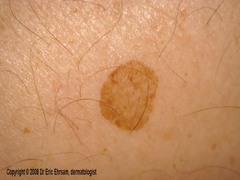
Macules

answer
FLAT, distinct, discolored area of skin that is usually less than 1 cent wide. It usually does not include change in skin texture of thickness.
question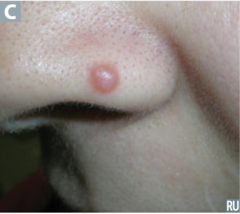
Papule

answer
solid or cystic RAISED spot on the skin that is less than one cent wide. Papules may be acuminate (pointed), dome-shaped, filifrom (thread-like), flat topped, oval or round, pedunculated (with a stalk), sessile (without a stalk), umbilicated (with a central depression), or verrucus (warty)
question
Pedunculated vs. sessile
answer
Pedunculated = with a stalk, Sessile = without a stalk
question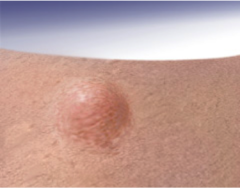
Nodule

answer
raised solid lesion MORE than 1 cm and may be in the epidermis, dermis, or subcutaneous
question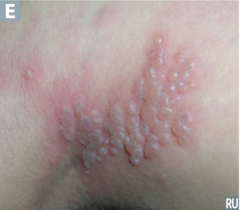
Vesicle

answer
raised lesions LESS than 1 cm in diameter that are filled with clear fluid
question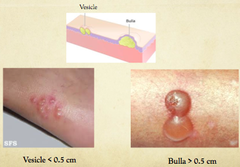
Bullae

answer
circumscribed fluid-filled lesions that are MORE than 1 cm in diameter
question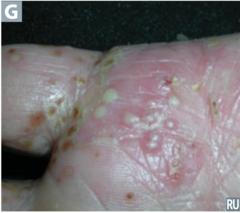
Pustule

answer
circumscribed elevated lesions that contain pus. They are most commonly infected (as in folliculitis) by may be sterile (as in pustular psoriasis)
question
Talengiectsia
answer
permanent dilatation of superficial blood vessels in the skin and may occur as isolated phenomena or as a part of a generalized disorder, such as Ataxia Telangiectsia
question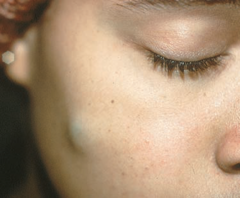
Cyst

answer
papule or nodule that contains fluid so is fluctant
question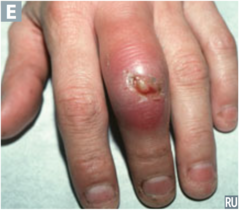
Abscess

answer
localized collection of pus
question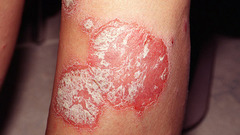
Scale (secondary lesion)

answer
flakes or plates that represent compacted desquamated layers of stratus corneum. Desquamation occurs when there are peeling sheets of scale following acute injury to the skin.
question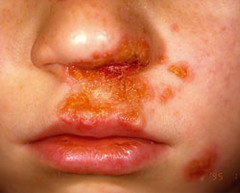
Crust (secondary lesion)

answer
result of the drying of plasma or exudate on the skin. Remember that crusting is different from scaling. The two terms refer to different phenomena and are NOT INTERCHANGEABLE. One can usually be distinguished from the other by appearance alone.
question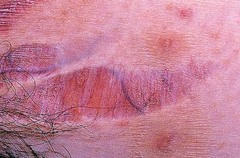
Atrophy (secondary lesion)

answer
thinning or absence of the epidermis or subcutaneous fat
question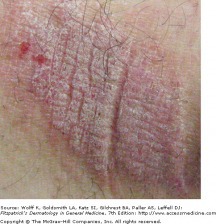
Lichenification (secondary lesion)

answer
thickening of the epidermis seen with exaggeration of normal skin lines. It is usually due to chronic rubbing or scratching of an area
question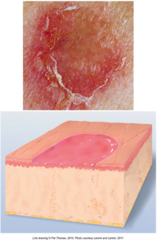
Erosion (secondary lesion)

answer
slightly depressed areas in which part or all of the epidermis has been lost
question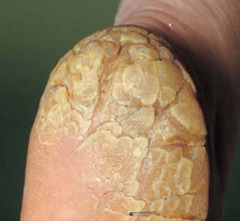
Fissure (secondary lesion)

answer
linear cleavage of skin which extends into the dermis
question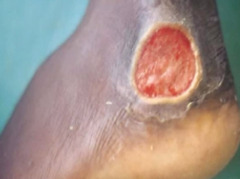
Ulceration (secondary lesion)

answer
necrosis of the epidermis and dermis and sometimes of the underlying subcutaneous tissue
question
Eschar (secondary lesion)
answer
hard, usually darkened, plaque convering an ulcer implying extensive tissue necrosis, infarcts or gangrene
question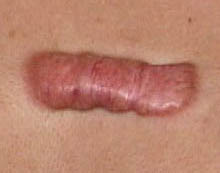
keloid (secondary lesion)

answer
exagerated connective tissue response of injured skin that extend beyond the edges of the original wound. Type of scar that is firm, rubbery lesions or shiny, fibrous nodules, and can vary from pink to the color of the patient's flesh or red to dark brown.
question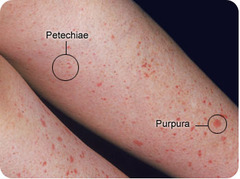
Petechiae and papura (secondary lesion)

answer
refers to bleeding that occurs in the skin, petechiae usually refers to smaller lesions, while papura and ecchymoses are terms that refer to larger lesions. None of these blanch when pressed.
question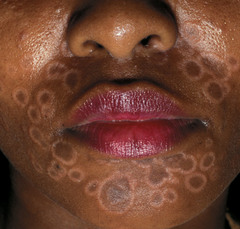
Granuloma (secondary lesion)

answer
histological term referring to chronic inflammation in which there are several types of inflammatory cells, including giant cells. Granulomas form in response to foreign bodies, certain infections (tuberculosis, leprosy) and inflammatory skin diseases (granuloma annulare, granuloma faciale, sarcoidosis)
question
Annular
answer
lesions that are seen in a ring shape
question
Confluent
answer
lesions that tend to run together
question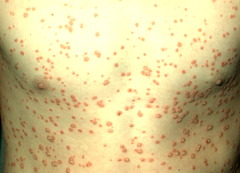
Guttate

answer
lesions that looks as though someone took a dropper and dropped this lesion on the skin. Characteristic of psoriasis
question
Multiform
answer
lesions that occur in a variety of shapes
question
Univesalis
answer
widespread disorder that affects the entire skin
question
Morbiliform
answer
rash that looks like measles. Patients with measles will have the rash but patients with Kawasaki disease, drug rxn, or other conditions may also present with this. The rash consists of macular lesions that are red and are usually 2-10 mm in diameter but may be confluent in places.
question
Consistency may be described as....
answer
soft, firm, hard, fluctuant or sclerosed
question
Verruca
answer
a wart, may present on skin or mucus membrane
question
Pruritis
answer
severe itching of the skin
question
Ephelids
answer
freckles, which are concentrations of melanized cells
question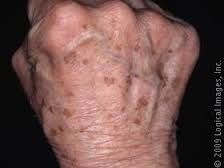
Solar lentigo/Ink spot lentigo

answer
harmless patch of darkened skin which results from UV exposure that causes proliferation of melanocytes. These are common in people over the age of 40 years. "Age spots"
question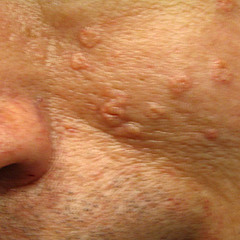
Globules

answer
large dots that represent localized pigment
question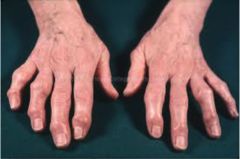
Heberdon's nodes

answer
hard or bony swellings that can develop in the distal interphalangeal joints (DIP). They are a sign of osteoarthritis and are caused by formation of osteophytes of the articular cartilage in response to repeated trauma of the joint.
question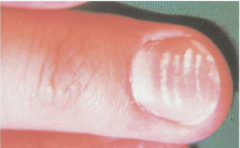
Leukonychia

answer
white nails or milk spots that appear due to white discoloration from injury to the base of the nail
question
Nevus
answer
a mole, benign by deffinition
question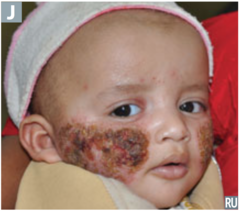
Impetigo

answer
caused by strep or staph strain bacteria. Impetigo is caused when there is a break in the skin and the bacteria that already exist on the skin, enter the body and grow. Breaks in the skin may occur from injury or trauma to the skin or from insect, animal or human bites.
question
Impetiginized
answer
impetigo in addition to an underlying dermatological condition
question
Violaceous
answer
of violet color
question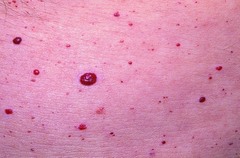
Angioma

answer
common skin growths that can grow on most areas of the body
question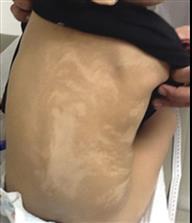
Hypomelanosis

answer
a rare condition characterized by areas of the body that lack skin color and can present as patches, steaks, or spiral-shaped (whorled) areas.
question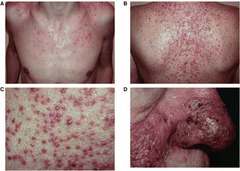
Acneiform eruption

answer
these are dermatosus that resemble acne vulgaris. Lesions may be papulopustular, nodular or cystic. They are follicular eruptions characterized by papules and pustules resembling acne
question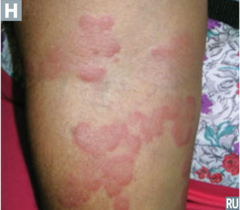
Urticaria

answer
hives
question
Malar
answer
relating to the zygomatic bone or the cheek
question
Alar crease
answer
side wall creases of the nose
question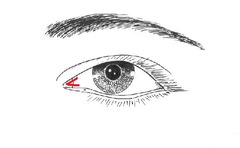
Canthus

answer
outer or inner corner of the eye, where the upper and lower lids meet
question
Electrodessication and Curretage (ED&C)
answer
scraping or burning off skin growths, this can be used for LESS SERIOUS skin cancers, pre-cancers and benign growths. A local anesthetic is injected, and then the abnormal tissue is scraped off with a special tool. The area is then cauterized until bleeding stops
question
Shave biopsy
answer
slices a surface growth off using a blade. A "curette" does a similar task with a special scraping tool. Often performed to remove a small growth and confirm its nature at the same time.
question
Punch biopsy
answer
typically used by dermatologists to sample skin rashes and small growths. After a local anesthetic is injected, a biopsy punch is used to cut out a cylindrical piece of skin. The hole may be closed with a suture and heals with minimal scarring.
question
UVB Phototherapy
answer
tx for skin eruptions using artificial UV light
question
Intralesional Injections
answer
Direct placement of a medication into a problem skin area through a very fine needle. Most often, a dilute solution of triamcinalone (Kenalog) is used. Acne cysts, psoriasis and chronic forms of eczema are treated this way. If too much medication is used, a white spot or dent develops, but usually goes away.
question
Pared and Cryo'd
answer
pared means to trim or cut away its outer edges. Cryo'd is short for something that has endured cryotherapy. Most commonly used to treat a number of disease and disorders, most especially skin conditions like warts, moles, skin tags and solar keratoses.
question
Squamous cell carcinoma in situ (SCCis)
answer
refers to stage 0 squamous cell carcinoma, cancer discovered in this stage is ONLY PRESENT in the epidermis and has not spread deeper to the dermis.
question
Pitting edema
answer
this is observable swelling of body tissues due to fluid accumulation that may be demonstrated by applying pressure to the swollen area. If the pressing causes and indentation that persists for some time after the release of the pressure, the edema is referred to as pitting.
question
Stasis dermatitis
answer
A condition that develops in people who have poor circulation. This is most common in the lower legs because leg veins have one-way valves. As people age, these valves can weaken and stop working properly. Some blood can leak out and pool in the legs.
question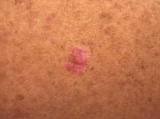
Basal Cell Carcinoma (BCC)

answer
Most common form of skin cancer; caused by unprotected exposure to UV rays. Often small, dome-shaped, pimple-like growth that has pearly color. Blood vessels may be seen on the surface.
question
Cutaneous T-Cell Lymphoma
answer
This occurs when malignant T cells are attracted to the skin and can appear anywhere on the body surface. Can present as a rash or thick lesion depending on severity
question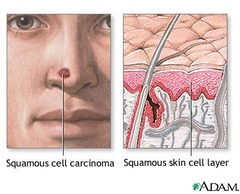
Squamous Cell Carcinoma (SCC)

answer
2nd most common type of cancer (nonmelanoma); usually presents as red crusted or scaly patch on the skin, a nonhealing ulcer, or a firm red nodule
question
Actinic Keratosis (AK)
answer
Common skin lesions caused by years of UV exposure; also referred to as "sun spots"; considered the earliest stage in the development of skin cancer
question
Alopecia Areata (AA)
answer
Causes hair loss in small, round patches that may go away on their own, or last for years. 5% with AA may lose all scalp hair (alopecia totalis) and body hair (alopecia universalis); caused by autoimmune rxn with attacks hair roots
question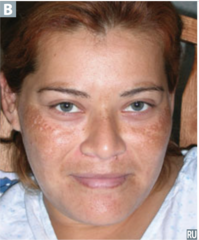
Melasma

answer
Skin discoloration that appears dark, irregular-shaped patches with well-defined edges.
question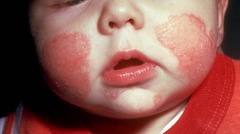
Eczema/Atopic Dermititis

answer
Common condition described as the "itch that rashes"; scratching often leads to redness, swelling, cracking, "weeping" of clear fluid, crusting and scaling of the skin. 10-20% of children and 1-2% of adults develop this condition
question
16 types of common benign growths
answer
dermatofibroma prurigo nodularis keratoacanthoma pyogenic granuloma cysts (epidermoid and pilar) milia sebaceous gland hyperplasia digital mucinous pseudocyst lipoma xanthelasma skin tag syringoma neurofibroma cherry angioma seborrheic nevus (mole)
question
Rosacea
answer
Common skin condition that develops in people of all races; often small, red, pus-filled bumps on the face. Most commonly affects middle-aged women with fair skin. Key symptoms: facial redness, swollen red bumps and visible blood vessels
question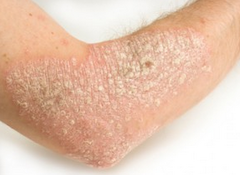
Psoriasis/ Psoriatic Arthritis

answer
A chronic condition that develops when the immune system causes hyperproliferation of skin cells. Typically, new skin cells form over several weeks but in psoriasis pts the skin cells form in days
question
Seborrheic Keratosis (SK)
answer
Common, benign skin growth; Can occur almost anywhere on skin; often associated with older age and can be easily mistaken for other common skin growth such as warts or nevus
question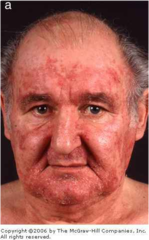
Seborrheic Dermatitis

answer
Common skin disease that causes a red, itchy rash with scales; most often affects the scalp, sides of the nose, eyebrows, ears, eyelids and middle of the chest. Chronic condition but easily treated



